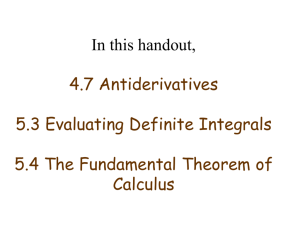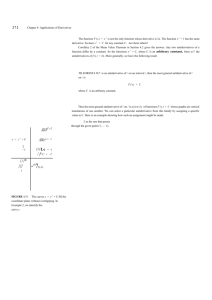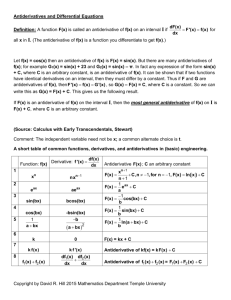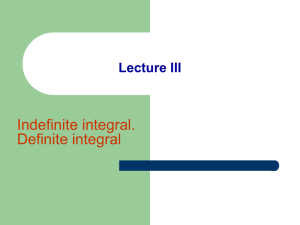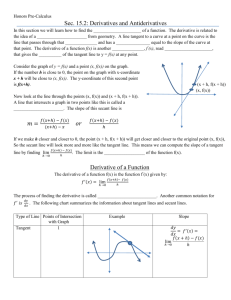FLC Math 400 Calculus I 5.1 Antiderivatives and Indefinite
advertisement
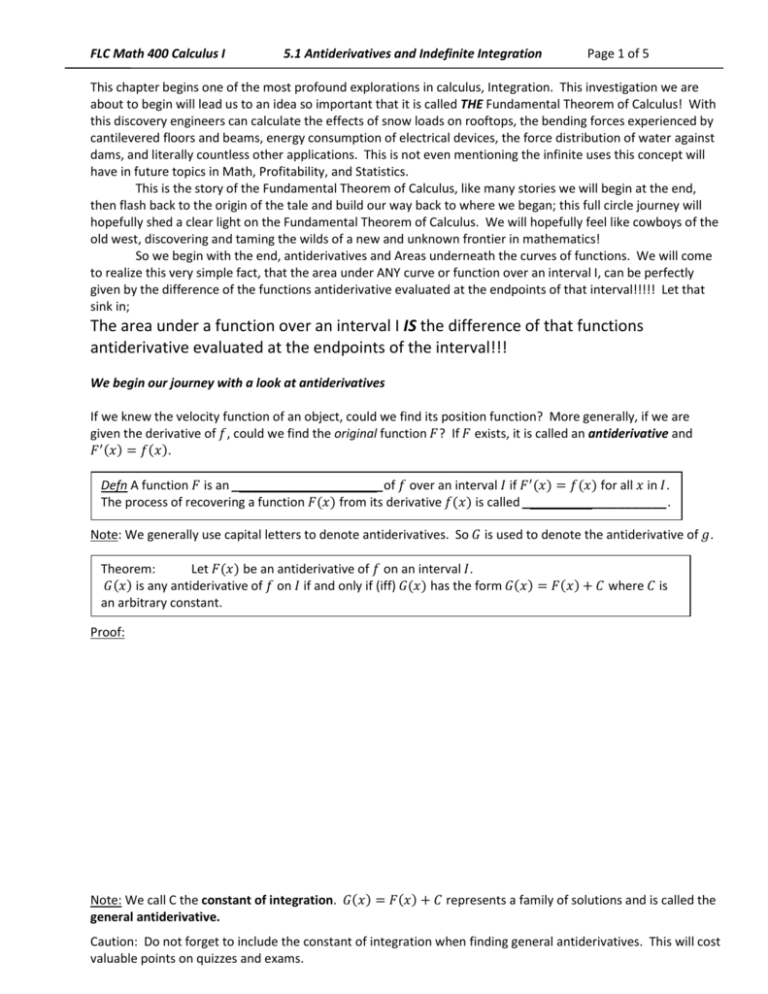
FLC Math 400 Calculus I 5.1 Antiderivatives and Indefinite Integration Page 1 of 5 This chapter begins one of the most profound explorations in calculus, Integration. This investigation we are about to begin will lead us to an idea so important that it is called THE Fundamental Theorem of Calculus! With this discovery engineers can calculate the effects of snow loads on rooftops, the bending forces experienced by cantilevered floors and beams, energy consumption of electrical devices, the force distribution of water against dams, and literally countless other applications. This is not even mentioning the infinite uses this concept will have in future topics in Math, Profitability, and Statistics. This is the story of the Fundamental Theorem of Calculus, like many stories we will begin at the end, then flash back to the origin of the tale and build our way back to where we began; this full circle journey will hopefully shed a clear light on the Fundamental Theorem of Calculus. We will hopefully feel like cowboys of the old west, discovering and taming the wilds of a new and unknown frontier in mathematics! So we begin with the end, antiderivatives and Areas underneath the curves of functions. We will come to realize this very simple fact, that the area under ANY curve or function over an interval I, can be perfectly given by the difference of the functions antiderivative evaluated at the endpoints of that interval!!!!! Let that sink in; The area under a function over an interval I IS the difference of that functions antiderivative evaluated at the endpoints of the interval!!! We begin our journey with a look at antiderivatives If we knew the velocity function of an object, could we find its position function? More generally, if we are given the derivative of 𝑓, could we find the original function 𝐹? If 𝐹 exists, it is called an antiderivative and 𝐹 ′ (𝑥) = 𝑓(𝑥). Defn A function 𝐹 is an ______________________of 𝑓 over an interval 𝐼 if 𝐹 ′ (𝑥) = 𝑓(𝑥) for all 𝑥 in 𝐼. The process of recovering a function 𝐹(𝑥) from its derivative 𝑓(𝑥) is called _____________________. Note: We generally use capital letters to denote antiderivatives. So 𝐺 is used to denote the antiderivative of 𝑔. Theorem: Let 𝐹(𝑥) be an antiderivative of 𝑓 on an interval 𝐼. 𝐺(𝑥) is any antiderivative of 𝑓 on 𝐼 if and only if (iff) 𝐺(𝑥) has the form 𝐺(𝑥) = 𝐹(𝑥) + 𝐶 where 𝐶 is an arbitrary constant. Proof: Note: We call C the constant of integration. 𝐺(𝑥) = 𝐹(𝑥) + 𝐶 represents a family of solutions and is called the general antiderivative. Caution: Do not forget to include the constant of integration when finding general antiderivatives. This will cost valuable points on quizzes and exams. FLC Math 400 Calculus I 5.1 Antiderivatives and Indefinite Integration Page 2 of 5 Basic Integration Rules Integration is the “inverse” operation to differentiation. So integrating will undo differentiation and differentiation will undo integration. The operator for integration with respect to x, is∫ Thus ∫ 𝑓 ′ (𝑥)𝑑𝑥 = 𝑓(𝑥) + 𝐶 & 𝑑 [∫ 𝑓 ′ (𝑥)𝑑𝑥] 𝑑𝑥 𝑑𝑥. = 𝑓(𝑥) Antidifferentiation Rules 1) Constant Multiple Rule: Function 𝑘𝑓(𝑥) General Antiderivative 𝑘𝐹(𝑥) + 𝐶 2) Negative Rule: −𝑓(𝑥) −𝐹(𝑥) + 𝐶 3) Sum of Difference Rule: 𝑓(𝑥) ± 𝑔(𝑥) 𝐹(𝑥) + 𝐶1 ± 𝐺(𝑥) + 𝐶2 = 𝐹(𝑥) ± 𝐺(𝑥) + 𝐶 FLC Math 400 Calculus I 5.1 Antiderivatives and Indefinite Integration Page 3 of 5 Ex 1 Find the general antiderivative of each function. (Find 𝐹(𝑥) so that 𝐹 ′ (𝑥) = 𝑓(𝑥).) 𝑓(𝑥) 2 3𝑥 2 4𝑥 3 𝑥𝜋 𝐹(𝑥) 𝑓(𝑥) sec 2 𝑥 𝑒𝑥 sin 13𝑥 𝑒 𝑘𝑥 𝐹(𝑥) 1 𝑥2 1 𝑥3 𝑥2 𝑥5 𝑥2 + 1 (𝑥 + 1)2 1 𝑥 𝑥 √𝑥 + √𝑥 𝑥2 1 1 + 𝑥2 𝑥 3 − 5𝑥 + 1 sin 𝑥 cos 𝑥 Ex 2 Find the general antiderivative for each function. (Differentiate your answer to check your work.) 1 a) 𝑓(𝑥) = 2 − 3𝑥 2 + 4 𝑥 4 1 2 9 𝑥3 b) 𝑓(𝑥) = − c) 𝑓(𝑥) = √𝑥 6 3 − 2 + 3𝑒 4𝑥 − 3 cos(3𝑥) 6 √𝑥 1 d) 𝑓(𝑥) = √𝑥 ( 𝑥 1/5 − 𝑥) 2 e) 𝑓(𝜃) = 𝑆𝑒𝑐𝜃(𝑡𝑎𝑛𝜃 − 𝑠𝑒𝑐𝜃)𝑑𝜃 FLC Math 400 Calculus I 5.1 Antiderivatives and Indefinite Integration Page 4 of 5 Indefinite Integrals Defn The set of all antiderivatives of 𝑓is the indefinite integral of 𝑓 with respect to 𝑥, denoted by ∫ 𝑓(𝑥) 𝑑𝑥. The symbol ∫ is an integral sign. The function 𝑓 is the integrand and 𝑥 is the variable of integration. Note: The indefinite integral is the general solution to the differential equation 𝑔(𝑥) = 𝑑𝑓(𝑥) 𝑑𝑥 Ex 3 Find each indefinite integral. √𝑥 1 a) ∫ (2 − 3𝑥 2 + 4 𝑥 4 ) 𝑑𝑥 𝑏) ∫ ( 6 − 6 √𝑥 ) 𝑑𝑥 Initial Value Problems and Differential Equations Differential equations are nearly the same thing as finding an antiderivative. A differential equation is an equation that involves a differential in it: 𝑑𝑦 𝑓(𝑥) = 𝑑𝑥 So finding the antiderivative of 𝑦 is the same thing as finding the general solution to the differential equation. Recall that the closest we can get to the antiderivative will be up to a constant. 𝑑𝑦 𝑓(𝑥) = has the general solution 𝐹(𝑥) + 𝐶 𝑑𝑥 (where 𝐹(𝑥) is the antiderivative of 𝑓(𝑥) or 𝑑(𝐹(𝑥)+ 𝐶) 𝑑𝑥 𝑑𝑦 = 𝑓(𝑥) = 𝑑𝑥) Consider the example 𝑑𝑦 = 3𝑥 2 𝑑𝑥 This differential equation has the General Solution 𝐹(𝑥) = 𝑦 = 𝑥 3 + 𝐶 Given a particular initial value (𝐹(1) = 1) we can find a particular solution. This is true of all differental equations. Finding the antiderivative consists of finding the general solution. To find the particular solution You must be given an initial value. At the end of the Calc. you may or may not choose to take an introduction to Differential Equations course. In Calc. II you will focus on many techniques used specifically for finding both General and Particular solutions to these and other Differential Equations. FLC Math 400 Calculus I 5.1 Antiderivatives and Indefinite Integration Ex: 5.1.56 Find the particular solution to the differential 𝑑𝑦 3 equation 𝐹 ′ (𝑥) = = , 𝑔𝑖𝑣𝑒𝑛 𝐹(𝑒) = 3 𝑑𝑥 Page 5 of 5 Ex: 5.1.66 Solve the differential equation: 𝑓 ′ (𝑠) = 6𝑠 − 8𝑠 3 , 𝑓(2) = 3 𝑥 Ex: 5.1.70 (if time) Find the particular solution to the D.E. 𝑓 ′′ (𝑥) = 𝑆𝑖𝑛 𝑥, 𝑓 ′ (0) = 1, 𝑓(0) = 6 Slope Fields: See http://www.mathscoop.com/calculus/differential-equations/slope-field-generator.php 𝑑𝑦 1 For the D.E. 𝑑𝑥 = 2 𝑥 − 1, (4,2) Each input 𝑥 yields an output. What is our interpretation of that 𝑑𝑦 1 output?________________. So a graph of 𝑑𝑥 = 2 𝑥 − 1 will give a bunch of slopes called a slope field. The slope at every 𝑥 corresponds to the slope of 𝑓 at 𝑥. By following the slope field you can get an idea of what a general solution looks like. The general solution passing through (4,2) will be the particular solution for that point. The slope field for this example is given below. Next to it is an analytic solution for the particular solution.


